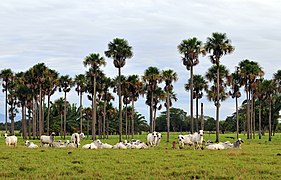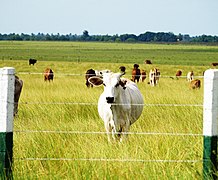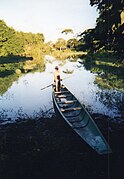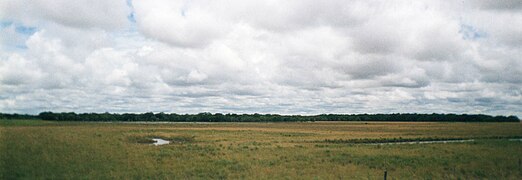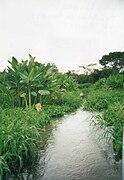Llanos
| Llanos | |
|---|---|
 The Llanos inColombia | |
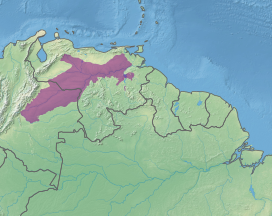 Location of the Llanos | |
| Ecology | |
| Realm | Neotropical |
| Biome | tropical and subtropical grasslands, savannas, and shrublands |
| Borders | |
| Geography | |
| Area | 375,786 km2(145,092 sq mi) |
| Countries | |
| Conservation | |
| Conservation status | Vulnerable |
| Protected | 105,323 km² (28%)[1] |
TheLlanos(SpanishLos Llanos,"The Plains";Spanish pronunciation:[losˈʝanos]) is a vasttropical grasslandplainsituated to the east of theAndesinColombiaandVenezuela,in northwestern South America. It is anecoregionof thetropical and subtropical grasslands, savannas, and shrublandsbiome.
Geography[edit]
The Llanos occupy a lowland that extends mostly east and west. The Llanos are bounded on the west and northwest by theAndes,and on the north by theVenezuelan Coastal Range.TheGuiana Highlandsare to the southeast, and theNegro-Branco moist forestsare to the southwest. To the east theOrinoco wetlandsandOrinoco Delta swamp forestsoccupy theOrinoco Delta.[2]
The Llanos' main river is theOrinoco,which runs from west to east through the ecoregion and forms part of the border between Colombia and Venezuela. The Orinoco is the major river system of Venezuela.[3]
Climate[edit]
The ecoregion has atropical savanna climatethat grades into atropical monsoon climatein the Colombian Llanos. Rainfall is highly seasonal, with a rainy season from April to November, and a dry season between December and March. The wettest months are typically June and July. Rainfall varies across the ecoregion, from up to 3,000 millimetres (120 in) per year in the southwest, 1,200 to 1,600 millimetres (47 to 63 in) inApureState, and 800 to 1,200 millimetres (31 to 47 in) per year in the Llanos ofMonagasState in the northeast. Mean annual temperature is 27 °C or 80.6 °F, and the average monthly temperature varies little throughout the year; the lowest-temperature months (June, July, December, and January) are only 2 °C or 3.6 °F cooler than the hottest months.[2]
Flora[edit]
The plant communities in the Llanos include open grasslands, savannas with scattered trees or clumps of trees, and small areas of forest, typicallygallery forestsalong rivers and streams. There are seasonally flooded grasslands and savannas (llano bajo) and grasslands and savannas that remain dry throughout the year (llano alto).[2]
The llano alto grasslands and savannas are characterized by grasses and shrubs 30–100 cm high, formingtussocks10 to 30 cm apart. Soils are typically sandy and nutrient-poor. Llano alto covers approximately two-thirds of the Venezuelan llanos, and is also widespread in the Colombian llanos. Grasses of genusTrachypogonare predominant, and species includeTrachypogon plumosus,T. vestitus,Axonopus canescens,A. anceps,Andropogon selloanus,Aristidaspp.,Leptocoryphium lanatum,Paspalum carinatum,Sporobolus indicus,andS. cubensis,andsedgesin the generaRhynchosporaandBulbostylis.Shrubs and herbs are most commonlylegumesin the generaMimosa,Cassia,Desmodium,Eriosema,Galactia,Indigofera,Phaseolus,Stylosanthes,Tephrosia,andZornia.The trees manteco (Byrsonima crassifolia), chaparro (Curatella americana), and alcornoque (Bowdichia virgilioides) are the most common, growing either as scattered trees or in woodland patches known asmataswhich range in area from 12 meters in diameter up to a hectare.[2]
During the rainy season from May to October, parts of the Llanos can flood up to a meter. This turns somesavannassandgrasslandsinto temporarywetlands,comparable to thePantanalof central South America. This flooding also creates habitat for water birds and other wildlife. These seasonally flooded grasslands and savannas, known as llano bajo, typically have richer soils. They are characterized by the grassPaspalum fasciculatum.Trees include the palmCopernicia tectorumand gallery forest species.[2]
Gallery forests include evergreen seasonally flooded forests, and semi-deciduous forests on higher ground. Morichales are seasonally flooded forests characterized by themoriche palm(Mauritia flexuosa). Vegas are seasonally flooded evergreen forests found along the Orinoco and its tributaries. Trees form a canopy 8 to 20 meters high, and includeIngaspp.,Combretum frangulifolium,Gustavia augusta,Pterocarpussp.,Pterocarpus dubius,Spondias mombin,andCopaifera pubiflora.[2]
Semi-deciduous forests occur above flood level, and form a canopy 12 to 15 meters high. Common trees includeTabebuia billbergii,Godmania aesculifolia,Cassia moschata,Spondias mombin, Copaifera pubiflora,Bourreria cumanensis,Cordiaspp.,Bursera simaruba,Cochlospermum vitifolium,Hura crepitans,andAcacia glomerosa.[2]
"Matorrales" are deciduous and semi-deciduous shrublands 5 to 8 meters high which cover large areas in the central Venezuelan llanos, and may be a form of secondary vegetation in areas that were formerly dry deciduous forest. Typical shrubs areBourreria cumanensis,Randia aculeata,Godmania aesculifolia,Pereskia guamacho,Prosopisspp.,Xylosma benthamii,Erytroxylumsp., andCereus hexagonus.[2]
Fauna[edit]
Mammals of the grassland and savanna includewhite-tailed deer(Odocoileus virginianus),giant anteater(Myrmecophaga tridactyla),capybara(Hydrochoerus hydrochaeris),giant armadillo(Priodontes maximus),Eastern cottontail(Sylvilagus floridanus),Alston's cotton rat(Sigmodon alstoni),Hispid cotton rat(S. hispidus),Zygodontomys brevicauda,andOecomys bicolor.[2]
The gallery forests are home to more diverse large and medium-sized mammals, includingcollared peccary(Tayassu tajacu),white-lipped peccary(T. pecari),South American tapir(Tapirus terrestris), white-tailed deer,red brocket(Mazama americana),wedge-capped capuchin(Cebus olivaceus),Venezuelan red howler(Alouatta seniculus), large rodents like thelowland paca(Cuniculus paca),agoutis(Dasyproctaspp.), andBrazilian porcupine(Coendou prehensilis), and large cats like thepuma(Puma concolor),jaguar(Panthera onca), andocelot(Leopardus pardalis). The endangeredgiant otter(Pteronura brasiliensis) lives along the Orinoco and its tributaries.[2]
Some of thelargest jaguarsin the world are found in the Llanos, with average weights of over 100 kg (220 lb) for males.[4]
TheLlanos long-nosed armadillo(Dasypus sabanicola) and the short-tailed opossumMonodelphis orinociareendemicto the Llanos.[2]
The Llanos' wetlands supports around 70 species ofwater birds,including thescarlet ibis.[3]A large portion of the distribution of thesharp-tailed ibis(Cerbibis oxycerca) andwhite-bearded flycatcher(Phelpsia inornata) is in the Llanos.
Native reptiles include theOrinoco crocodile(Crocodylus intermedius),spectacled caiman(Caiman crocodilus),Green anaconda(Eunectes murinus), andArrau turtle(Podocnemis expansa), which live in the ecoregion's wetlands.
-
Spectacled caiman,Guaratico River, Venezuela
Indigenous peoples[edit]
Indigenous peoplesof the Llanos include theGuahiboin the western Llanos of Colombia and Venezuela, and theYaruroin the eastern Llanos in Venezuela.
Cattle raising and farming[edit]
The primary economic activity in the Llanos since theSpanish colonial erais the herding of millions of cattle. An 1856 watercolor byManuel María Pazdepicts sparsely populated open grazing lands with cattle and palm trees.[5]The termllanero( "plainsman" ) became synonymous with the cowhands that took care of the herds, and had some cultural similarities with thegauchosof thePampasor thevaquerosofSpanishandMexican Texas.
Decades of extensive cattle raising has altered the ecology of the Llanos. Grasslands and savannas are frequently burned to make them more suitable for grazing and eliminate trees and shrubs. Non-native grasses have been introduced for cattle fodder, including the African grassMelinis minutiflora,and now cover large areas.[2]
Agriculture, particularly rice and maize, now cover extensive areas, including rice fields in former seasonal wetlands.
Oil and gas[edit]
In Los Llanos, the governments of Venezuela and Colombia had developed a strong oil and gas industry in the zones of Arauca, Casanare, Guárico, Anzoátegui, Apure and Monagas. TheOrinoco Belt,entirely in Venezuelan territory, consists of large deposits of extraheavy crude(oil sands). The Orinoco belt oil sands are known to be one of the largest, behind that of theAthabasca Oil SandsinAlberta,Canada. Venezuela's non-conventional oil deposits of about 1,200 billion barrels (1.9×1011m3), found primarily in the Orinoco oil sands, are estimated to approximately equal the world's reserves of conventional oil.[citation needed]
Protected areas[edit]
A 2017 assessment found that 105,323 km², or 28%, of the ecoregion, is in protected areas.[1]Protected areas includeAguaro-Guariquito National Park(5,857.5 km²),Cinaruco-Capanaparo National Park(5,843.68 km²),Tortuga Arrau Reserve(98.56 km²), andCaño Guaritico Wildlife Refuge(93.0 km²) in Venezuela, andEl Tuparro National Natural Park(5,549.08 km²) in Colombia.[2][6]
Gallery[edit]
-
Colombia
-
Venezuela
-
The Guaratico River near Mantecal, Venezuela
-
Tourist metal bongo on the Guaratico River
-
The flat, expansive Llanos
-
Wet season
-
Sunset
-
Thunderstorm tracks
Cities situated in the Llanos[edit]
In Colombia[edit]
- Acacías
- Arauca, Arauca
- Gaviotas
- Maní, Casanare
- Orocué
- Paz de Ariporo
- Puerto Carreño
- Inírida
- Puerto López, Meta
- San José del Guaviare
- Saravena
- Tame
- Villavicencio
- Yopal
- Fortul
In Venezuela[edit]
- Acarigua
- Araure
- Barinas
- Calabozo
- Caripito
- El Tigre
- Guanare
- Maturín
- Puerto Ayacucho
- Sabaneta
- San Carlos
- San Fernando de Apure
- Tucupita
- Valle de la Pascua
See also[edit]
References[edit]
- ^abEric Dinerstein, David Olson, et al. (2017). An Ecoregion-Based Approach to Protecting Half the Terrestrial Realm, BioScience, Volume 67, Issue 6, June 2017, Pages 534–545; Supplemental material 2 table S1b.[1]
- ^abcdefghijklm"Llanos".Terrestrial Ecoregions.World Wildlife Fund.
- ^abEarth.Doring Kindersley. 2003. p. 328.ISBN1-4053-0018-3.
- ^Jedrzejewski, W.; Abarca, M. R.; Viloria, Á.; Cerda, H.; Lew, D.; Takiff, H.; Abadia, E.; Velozo, P. (2011)."Jaguar conservation in Venezuela against the backdrop of current knowledge on its biology and evolution"(pdf).36(12). Interciencia: 954–966.Retrieved2019-07-12.
{{cite journal}}:Cite journal requires|journal=(help) - ^Paz, Manuel María."General View of The Plains, Province of Casanare".World Digital Library.Retrieved2014-05-21.
- ^UNEP-WCMC (2020). Protected Area Profile for Venezuela (Bolivarian Republic of) from the World Database of Protected Areas, September 2020. Available at: www.protectedplanet.net
External links[edit]
- (in English)"Llanos".Terrestrial Ecoregions.World Wildlife Fund.
- (in English)Dawn on the PlainsPhoto Feature,Havana Times,Oct 1, 2010.
- (in Spanish)The llanos music
- (in Spanish)The llanos of Colombia and Venezuela
- (in Spanish)Los Llanos de Colombia



